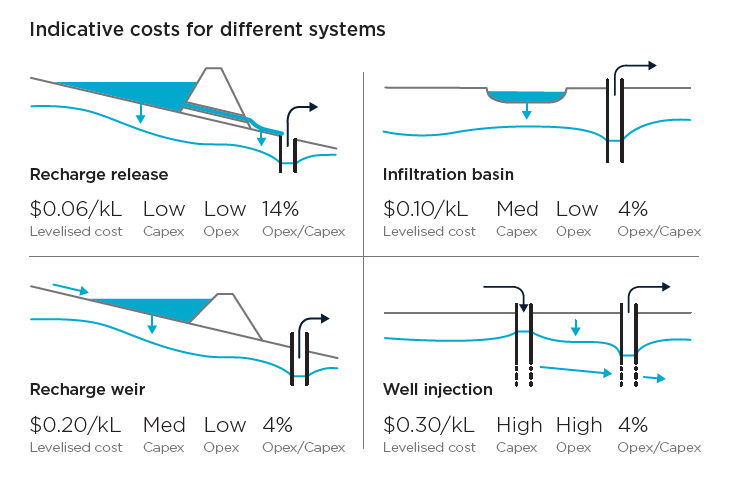Australian community, Stanthorpe, went from trucking in water daily in 2020 to recovering from floods in 2021.
Despite recent rain, parts of eastern Australia have only recently emerged from an intense and widespread multi-year drought.
In 2019-2020, nearly 50 communities in New South Wales and southern Queensland were within months of running out of water. For many farmers, this drought disrupted crop and livestock production and led to lost income.
With a changing climate, Australia is expected to face more of these weather extremes in the future.
As communities go from flood recovery to preparing for the next drought, it raises the question: how can water be better put aside for future use?
Banking water to prepare for drought
CSIRO groundwater systems expert, Declan Page, is exploring water banking opportunities to better prepare for drought.
Dr Page said opportunities exist to use surface reservoirs in dams in conjunction with underground storage in aquifers.
“Dams can be used to reduce flood impacts by storing water, but when also used for water supply, they can lose a lot of water to evaporation,” Dr Page said.
“We could use existing dams to replenish underground aquifers creating water banks for future use when surface water storages dry up.”
Rainwater captured in an existing dam, can be slowly, trickle fed to infiltrate or recharge an aquifer to become an underground reservoir. To do this, we use a technique known as managed aquifer recharge (MAR).
Why bank water underground?
Replenishing groundwater could make it available for use during a drought, providing Australian communities and the agriculture industry with greater water security.
Advantages are that aquifers can hold a large water capacity and there’s no evaporation. There’s also no risk of mosquitoes or algae.
CSIRO groundwater expert, Joanne Vanderzalm, explained how it works.
“MAR is a catch-all term for a system to replenish groundwater resources intentionally, safely and in a way that conserves the surrounding environment,” Dr Vanderzalm said.
“Geographical assessments determine exactly where suitable underground aquifers are and ensure they have capacity to store water.
“Other factors to assess are their proximity to the source of water for recharge or the demand for water supply so that water can be effectively recharged and later recovered economically.”
The ultimate MAR system set-up used depends on the aquifer and intended end use, such as whether the water will be used for irrigation or town drinking water supplies.
Cost-effective insurance against drought
MAR uptake is growing but is still relatively small. In Australia, 8.3 per cent of Australia’s yearly groundwater extraction was replenished through MAR, despite there being greater opportunities.
“Costs are one of the real uncertainties that hold MAR back,” Dr Vanderzalm explained.
“There can be more uncertainty in storing water underground, which requires investigations to understand the properties of the subsurface, such as infiltration rate or groundwater salinity, before building the system.
“So water banking is often discounted in favour of traditional surface storage systems.”
But there is good news. In a recently published cost analysis study, CSIRO found that water banking can be cost-effective and feasible for town water and agriculture. CSIRO developed 10 hypothetical scenarios based on different MAR systems including recharge releases, infiltration basins, recharge weirs and well injections.
The most affordable solution involved a simple recharge release system coupled to an existing dam to recharge a shallow water table aquifer, costing six cents per kilolitre (1000 litres) for water suitable for irrigation purposes.
Comparatively, the highest cost came in at 36 cents per kilolitre for a deep, well injection system. This system was designed for coastal use to protect drinking water supply from sea water.
“Costs increased with greater system engineering and complexity, and if drinking water was one of the end uses.”
This work was undertaken as part of CSIRO’s Northern Australia Water Resource Assessment, prepared for the Australian Government.

Water costs must be feasible for farmers
Investing in MAR makes sense in areas where some groundwater is used for irrigation as it can replenish depleted aquifers.
Replenishing a groundwater resource can be viewed as expensive, but it’s more cost effective than carting in water during a drought crisis. Water cartage can cost millions of dollars per day and can be financially crippling at a time when communities can least afford it.
“In this way, water banking offers insurance against drought,” Dr Vanderzalm said.
“Setting up a MAR system is realistic for agriculture in sustaining enterprise-scale water supply, particularly for high-value crops.
“Surface run-off is the most appealing approach for farmers because it keeps costs to a minimum by reducing the need for water treatment before recharge.”
A regional approach to water security
A regional approach to water banking for areas like the Murray-Darling Basin would help to scale the benefits.
CSIRO has identified underground storage opportunities for around two to four cubic kilometres of water – the equivalent of four to eight Sydney Harbours – within suitable aquifers in the Murray-Darling Basin.
CSIRO is also working with the National Water Grid Authority to rapidly identify additional regional areas where MAR could support irrigated agriculture
“Through our Drought Resilience Mission, we are exploring with local communities, government and industry how to establish scalable demonstrations of water banking,” said Dr Page.
“This will build confidence in MAR and hopefully deliver strategic water banking schemes for drought resilience to regional Australia.”
CSIRO’s Drought Resilience Mission aims to reduce the impacts of Australian droughts by 30 per cent by 2030. Find out more.
